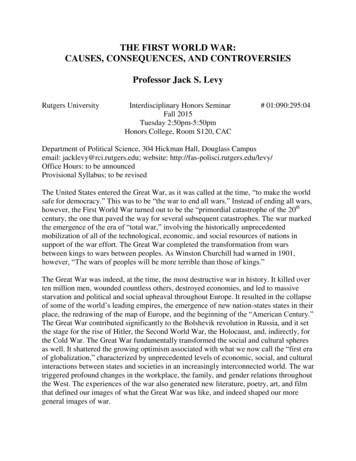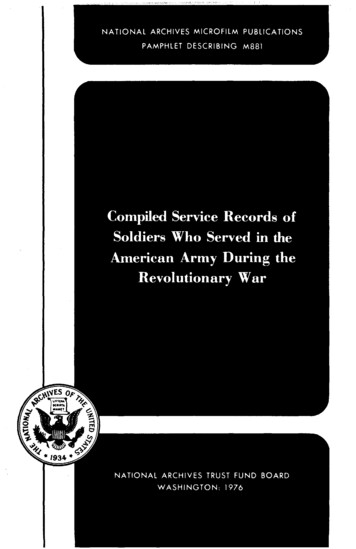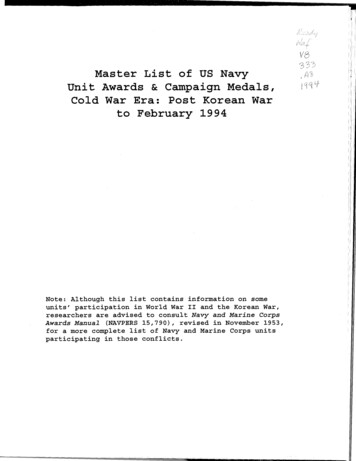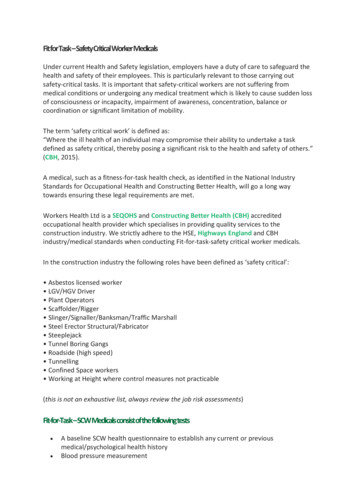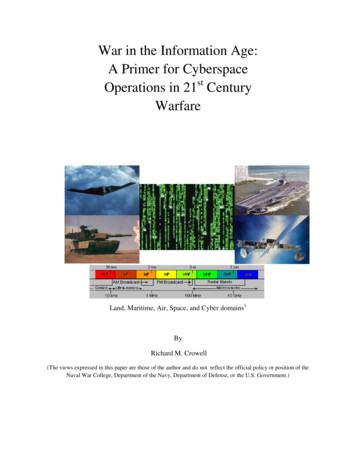
Transcription
War in the Information Age:A Primer for CyberspaceOperations in 21st CenturyWarfareLand, Maritime, Air, Space, and Cyber domains1ByRichard M. Crowell(The views expressed in this paper are those of the author and do not reflect the official policy or position of theNaval War College, Department of the Navy, Department of Defense, or the U.S. Government.)0
Form ApprovedOMB No. 0704-0188Report Documentation PagePublic reporting burden for the collection of information is estimated to average 1 hour per response, including the time for reviewing instructions, searching existing data sources, gathering andmaintaining the data needed, and completing and reviewing the collection of information. Send comments regarding this burden estimate or any other aspect of this collection of information,including suggestions for reducing this burden, to Washington Headquarters Services, Directorate for Information Operations and Reports, 1215 Jefferson Davis Highway, Suite 1204, ArlingtonVA 22202-4302. Respondents should be aware that notwithstanding any other provision of law, no person shall be subject to a penalty for failing to comply with a collection of information if itdoes not display a currently valid OMB control number.1. REPORT DATE3. DATES COVERED2. REPORT TYPE201000-00-2010 to 00-00-20104. TITLE AND SUBTITLE5a. CONTRACT NUMBERWar in the Information Age: A Primer for Cyberspace Operations in 21stCentury Warfare5b. GRANT NUMBER5c. PROGRAM ELEMENT NUMBER6. AUTHOR(S)5d. PROJECT NUMBER5e. TASK NUMBER5f. WORK UNIT NUMBER7. PERFORMING ORGANIZATION NAME(S) AND ADDRESS(ES)Naval War College,686 Cushing Road,Newport,RI,02841-12079. SPONSORING/MONITORING AGENCY NAME(S) AND ADDRESS(ES)8. PERFORMING ORGANIZATIONREPORT NUMBER10. SPONSOR/MONITOR’S ACRONYM(S)11. SPONSOR/MONITOR’S REPORTNUMBER(S)12. DISTRIBUTION/AVAILABILITY STATEMENTApproved for public release; distribution unlimited13. SUPPLEMENTARY NOTES14. ABSTRACT15. SUBJECT TERMS16. SECURITY CLASSIFICATION OF:a. REPORTb. ABSTRACTc. THIS PAGEunclassifiedunclassifiedunclassified17. LIMITATION OFABSTRACT18. NUMBEROF PAGESSame asReport (SAR)3219a. NAME OFRESPONSIBLE PERSONStandard Form 298 (Rev. 8-98)Prescribed by ANSI Std Z39-18
Information warfare consists of those actions intended to protect,exploit, corrupt, deny, or destroy information, or informationresources in order to achieve a significant advantage, objectives,or victory over an adversary.– Winn Schwartau, InfoWarCon 2009, Washington, DCInformation Warfare Circa 1981During the Cold War, the USSR was at least a decade behind the U.S. in computertechnology. To fill that void, the Soviets developed an aggressive program to steal U.S. andWestern science and technology. In 1981 French President Francois Mitterand passed vitalinformation to U.S. President Ronald Reagan. The case was designated Farewell by the FrenchDirection de la Surveillance du Territoire (DST), and later became known as the FarewellDossier.Some of the most useful information gained from the Farewell Dossier was the KGB‘s‗shopping list‘ for their most desired technology. In his book, At the Abyss, an Insider’s Historyof the Cold War, Thomas C. Reed, a former Director of the National Reconnaissance Office,recounts an incident of early computer warfare which was prompted by a KGB theft.The production and transportation of oil and gas was at the top of theSoviet wish list. A new trans-Siberian pipeline was to deliver naturalgas from the Urengoi gas fields in Siberia across Kazakhstan, Russia,and Eastern Europe, into the hard currency markets of the West. Toautomate the operation of valves, compressors, and storage facilities insuch an immense undertaking, the Soviets needed sophisticated controlsystems. They bought early model computers on the open market, butwhen Russian pipeline authorities approached the U.S. for the necessarysoftware, they were turned down. Undaunted, the Soviets looked elsewhere;a KGB operative was sent to penetrate a Canadian software supplier in anattempt to steal the needed codes. U.S. Intelligence, tipped by Farewell,responded and – in cooperation with some outraged Canadians –―improved‖ the software before sending it on.Once in the Soviet Union, computers and software, working together, ranthe pipeline beautifully – for a while. But that tranquility was deceptive.Buried in the stolen Canadian goods – the software operating this wholenew pipeline system – was a Trojan Horse. (An expression describing afew lines of software, buried in the normal operating system, that willcause that system to go berserk at some future date (Halloween?) or uponthe receipt of some outside message.) In order to disrupt the Soviet gassupply, its hard currency earnings from the West, and the internal Russianeconomy, the pipeline software that was to run the pumps, turbines, andvalves was programmed to go haywire, after a decent interval, to reset1
pump speeds and valve settings to produce pressures far beyond thoseacceptable to the pipeline joints and welds. The result was the mostmonumental non-nuclear explosion and fire ever seen from space. Atthe White House, we received warning from our infrared satellites ofsome bizarre event out in the middle of Soviet nowhere. NORADfeared a missile liftoff from a place where no rockets were known to bebased. Or perhaps it was the detonation of a small nuclear device. TheAir Force chief of intelligence rated it at three kilotons, but was puzzledby the silence of the Vela satellites. They had detected no electromagneticpulse, characteristic of nuclear detonation.2This event did not utilize the modern method of inserting malicious software (malware) viathe internet, but it was clearly the manipulation of a Supervisory Control and Data Acquisition(SCADA) system. SCADA are real time industrial process control systems that use computersand software to monitor and control systems from nuclear power plants and electric power gridsto railroad switching terminals and drinking water and sewage treatment facilities. Givenadvances in computers since the 1980s, one can easily envision the burgeoning risks of computerusage. Chaos can be created with the insertion of a Trojan horse, via malware into militarycommand, control, communications, computers, intelligence, surveillance and reconnaissance(C4ISR) systems or a power company‘s SCADA system. This could shut down or destroy apower grid supporting military command and control (C2) systems, resulting in an impotentmilitary. A similar attack against a civilian power grid during extreme cold weather could resultin millions of civilians freezing to death. Would this be a cyberspace operation? Would this bea weapon of mass destruction or effect (WMD/E)†?3 Would this merger of modes and means beclassified as hybrid warfare? Who would respond? What actions would the U.S. Department ofDefense take? Which command would respond? More importantly, how would the commanderneed to think about cyberspace operations?Traditionally, warfare has been waged in physical domains that can be seen and touched bythose who conduct operations in them.4 Until recently, there were four domains – land,maritime, air, and space. The information age‘s interconnected use of electronics, which movesdigitized data through the electromagnetic spectrum, has brought forth a fifth domain.Warfighters must now learn to operate and fight in this domain, called cyberspace.This paper will describe cyberspace, discuss cyberspace operations and depict theirrelationship to 21st century hybrid warfare. It will present the framework of operational art,specifically operational factors and functions as a tool for understanding operations incyberspace.5 A series of questions will be posed for future operational commanders to helpframe their thoughts on cyberspace. Additionally, it will postulate that cyberspace is a nearperfect domain in which to conduct hybrid wars.Cyberspace and the Information Environment†Weapon of mass destruction (WMD) is defined as chemical, biological, radiological or nuclear weapons capable of a high orderof destruction or causing mass casualties and exclude the means of transporting or propelling the weapon where such means is aseparable and divisible part from the weapon. Weapon of mass effect (WME) is defined as weapons capable of inflicting gravedestructive, psychological and or economic damage to the United States.2
The information age has been described by Winn Schwartau, author of numerous books on theInformation Age and Information Warfare, as ―computers everywhere.‖6 While much has beenwritten about the information age and its impact on modern warfare, the primary characteristic ofthe information age is the proliferation of information technology (IT). IT incorporatesinformation systems and resources (hardware, software, and wetware) used by military andcivilian decision makers to send, receive, control, and manipulate information necessary toenable 21st century decision making.7The combining of individuals, systems, content, and resources to enable decision makingforms the Information Environment (IE). The IE, a term of art, is defined in Joint Doctrine forInformation Operations as:The aggregate of individuals, organizations, and systems that collect,process, disseminate, or act on information. The actors include leaders,decision makers, individuals, and organizations. Resources include thematerials and systems employed to collect, analyze, apply, or disseminateinformation. The information environment is where humans andautomated systems observe, orient, decide, and act upon information,and is therefore the principal environment of decision making. Theinformation environment is made up of three interrelated dimensions:physical, informational, and cognitive These dimensions are inextricablylinked.8 (Emphasis added)The ability to understand cyberspace is directly related to comprehending how and whyinformation moves through the IE and how that information is used to influence human decisionmaking in both peace and war. While the nature of war remains unchanged, it is the characterthat is malleable. Today, the battle for the hearts and minds of the people around the globe isbeing waged in the IE with weapons that use information instead of physical means to compeldecision makers to act. Cyberspace, with its lack of traditional geometry, represents perhaps themost malleable of operating environments. It is paramount for 21st century military leaders tobecome comfortable working and fighting in this domain.The military capability most often used to maneuver within the information environment isinformation operations. U.S. Joint Military Doctrine defines Information Operations as:The integrated employment of the core capabilities of Electronic Warfare(EW), Computer Network Operations (CNO), Psychological Operations(PSYOP), Military Deception (Mil Dec), and Operations Security (OPSEC),in concert with specified supporting and related capabilities, to influence,disrupt, corrupt, or usurp adversarial human and automated decision-making,while protecting our own.9The information operations core capability most linked to cyberspace is computer networkoperations (CNO), which represent the tools used to navigate cyberspace. CNO are comprised ofcomputer network attack (CNA), computer network defense (CND), and related computernetwork exploitation (CNE) enabling operations.103
One of the primary goals of cyberspace operations is to affect decision making; in most cases,to influence a decision maker to decide in your favor. This can be done by gaining access to dataresident in electronics and using it to your advantage or simply moving information to and fromthe decision maker in order to achieve an effect or an objective. Operation BODYGUARD, theWorld War II strategic deception for the Allied invasion of Northern Europe, is a 20th centuryexample of moving information to a decision maker largely via the electromagnetic spectrum.‡The decision maker might be a civilian or military leader, or the local populace. The informationcan be moved by radio, television, cell phone, e-mail, hacking, or a phishing scheme.11 Therelationship between IO, cyberspace, and human interaction is best described by LieutenantColonel David T. Fahrenkrug, USAF and Dr. Daniel T. Kuehl, from the National DefenseUniversity, Information Resource Management College:While information operations thus includes all three dimensions of theinformation environment, [physical, informational, and cognitive]cyberspace comprises only a part—albeit perhaps a very large part—ofthe connectivity and content dimensions.12 Cyberspace is thus shapingand changing the three dimensions of the information environment: howwe create information content itself (a Web page, for example), how weshare that content through new forms of connectivity (the Internet linksthat make that Web page accessible to over a billion people), and howhuman interaction and communication are affected.13No one disputes the explosive expansion of cyberspace use. Around the globe, more andmore people are making decisions based on information gleaned from ‗information age‘ methodsrather than ‗industrial age‘ methods. The common thread with the information age means is thatthey use cyberspace – electromagnetic radiation, moving information to and from electronics,and ultimately the decision makers. The number of humans utilizing cyberspace forcommonplace activities (communication, news, shopping, banking, and entertainment) isgrowing exponentially. In Mumbai, India, a city of 13 million, use of cell phones and internet toreceive news grew from 1% to 48%, between 2006 and 2008.14 The 2008 CIA World Fact Bookstates that approximately 60 % of the world population and 86 % of the U.S. population use cellphones.15 We now have a President of the United States of America who cannot be without hisBlackBerry – connecting him to his most trusted friends and staff via cyberspace.16‡The deception relied heavily on convincing the German decision makers of three main objectives: 1) a large force will go toNorway and threaten Germany from the North. A fictitious army was created in Scotland. The British Fourth Army sent outthousands of ‗real‘ radio signals that were electronic deceptions; 2) the main invasion will come through the Pas de Calais,France. The First US Army Group (FUSAG) was created in the county of Kent (near Dover). Another ghost army, FUSAG withGeneral Patton as its real commander, also sent out thousands of ‗real‘ radio signals; 3) whatever happens in Normandy is a feint.The messages were reinforced by the truth because Dover to Calais is the shortest distance England to France, the beaches aroundCalais are large and flat, and it was the beginning of the shortest land route into Germany.Most of the information was moved via radio and Morse code signals. Additionally, in the early hours of June 6th the Alliesconducted an elaborate electronic deception in the form of air and sea assets emitting false targets. This presented the appearanceof an armada moving towards Calais. This information was reinforced by dozens of German agents, turned by the British XX(double cross) organization, sending electronic messages back to the Abwehr, German Intelligence HQ. All of this was done toconvince the German decision makers, primarily Adolph Hitler, to decide in the Allies favor.4
Cyberspace DefinitionsThere are disputes, however, as to the correct definition of cyberspace. As understanding anduse of this new domain evolves, so too does has the definition. Earlier definitions focused oncomputers and computer usage. The Oxford English Dictionary defines cyberspace as thenotional environment in which communications over computer networks occurs.17 Schwartau,states, ―Cyberspace is the intangible place between computers where information momentarilyexists on its route from one end of the global network to the other.‖18 Later definitions haveevolved to include all manner of electronic communications. Still disputed is whether or nothuman activity should be included in the definition of cyberspace.It is not surprising that our technology-oriented military exclude human activity from thedefinition of cyberspace. The Department of Defense (DOD) Quadrennial Roles and MissionsReview Report, published in January 2009, defines cyberspace as ―a global domain within theinformation environment consisting of the interdependent network of information technologyinfrastructures, including the Internet, telecommunications networks, computer systems, andembedded processors and controllers.‖19 The U.S. Chairman of the Joint Chiefs of Staffprovides a definition of cyberspace operations that addresses human activity; ―the employmentof cyber capabilities where the primary purpose is to achieve military objectives in or throughcyberspace. Such operations include computer network operations and activities to operate anddefend the Global Information Grid§.‖20Because humans are the inventors of information technology, the author supports a holisticapproach to the definition of cyberspace, to include both technology and human activity. Dr.Kuehl provides an inclusive definition of cyberspace that shows intertwining of domains andhuman activities.Cyberspace is a global domain within the information environment whosedistinctive and unique character is framed by the use of electronics and theelectromagnetic spectrum to create, store, modify, exchange, and exploitinformation via interdependent and interconnected networks using informationcommunications technologies.21Obviously, cyberspace would not exist without its component electronics and electromagneticspectrum (EMS). Electronics are the computers, smart phones, and hardware that havecomponents that direct electric current. The electromagnetic spectrum gives a physicaldefinition to cyberspace and relates directly to how digitized information moves throughcyberspace. In its most simple form, information (words, pictures, files, et al.) is converted todigital data in the form of binary code (1s and 0s) by the electronics. The digital data is placedinto ‗packets‘ and these are sent via electromagnetic radiation along the most secure andexpeditious route between two points. Radio, television, voice, and data signals are sent from atransmitter to a receiver, in the same way communication of old was sent on packet ships sailingthe Atlantic Ocean between England and New York.§The Global Information Grid (GIG) is defined in U.S. Joint doctrine as the globally interconnected end-to-end set ofcapabilities, associated processes and personnel for collecting, processing, storing, disseminating, and managing information ondemand to warfighters, policy makers, and support personnel.5
Two modern examples are the Apple iPhone and the maritime Automated InformationSystem (AIS). The iPhone moves information via the electromagnetic spectrum using the 850MHz frequency for voice and 1900 MHz frequency for data. The U.S. Department of HomelandSecurity and the U.S. Coast Guard describe AIS as a shipboard display system (e.g. radar, chartplotter, etc.) with overlaid electronic chart data that includes a mark for every significant shipwithin radio range; with a velocity vector (indicating speed and heading).22 Similar to theiPhone, the AIS uses two frequencies, 161.975 MHz and 162.025 MHz, to move information toand from the electronic displays. Incidentally, AIS can be bought in Europe for approximatelyUS 500 and in early 2009, Somali pirates were reported to be using AIS to identify and tracktheir targets.23Electronics and the electromagnetic spectrum in the cyberspace domain may be betterunderstood when viewed as an analogy for ships and the sea in the maritime domain. Just ascrucial as the human activity planning, directing and operating in the maritime domain is thehuman activity in the cyberspace domain. Globally, increasingly more people get theirinformation from electronics - satellite television, personal computers, smart phones, blogs, newmedia, or social networking sites**.24 In 2007, 84% of the population of Moscow, Russia ownedcell phones.25 In that year, 45% of Muscovites used cell phones and the internet to get news.26Individuals are also increasingly using cyberspace to make decisions, to interact, and to effectaction. As we move deeper into the 21st century, more and more human activity will occur incyberspace. These activities will include, but are not limited to, legal and illegal activities suchas entertainment, banking, networked communication, identity theft, information theft, andmonetary theft. Examples of the scope of global activity in cyberspace in the early 21st centuryinclude approximately 1.6 billion internet users (or 24 percent of people on earth);27approximately 190 million direct broadcast satellite (DBS) television viewers;28 and more than175 million Facebook users.29 In November 2008, nearly U.S. 3Trillion were movedelectronically per day in electronic funds transfers (EFT).30Paralleling the rapid expansion of civilian cyberspace use is the increasing use of cyberspaceby modern militaries. Many militaries now rely almost exclusively on cyberspace to moveinformation to decision makers–commanders and troops. Military uses of cyberspace include email (unclassified and classified), chat (in various commercial formats), Video Teleconference(VTC), Global Command and Control System (GCCS), Global Transportation Network (GTN),In-Transit Visibility (ITV), Joint Tactical Radio System (JTRS), Blue Force Tracker (BFT),Theater Battle Management Control System (TBMCS), Link 11 and Link 16 Data Link Systems,Unmanned Aerial Systems (UAS, i.e. Global Hawk and Predator), Global Positioning System(GPS), and Joint Direct Attack Munitions (JDAM).DOD Cyberspace OperationsThe likelihood of tactical actions in cyberspace having strategic effects has led the U.S.Department of Defense to develop specific organizational structures for cyberspace operations.**New media and social networking enable near instantaneous direct communication between individuals andgroups. Both use cyberspace and electronics to move information in order to influence human decision making.New media and social networking are extremely important to understanding social interaction and decision making,mainly because of the potential viral nature of this type of communication; however, they are beyond the scope ofthis paper.6
In his 2007 article, Warfighting in Cyberspace, Lieutenant General Keith Alexander, USA,Director of the National Security Agency (NSA) and Commander Joint Functional ComponentCommander – Network Warfare (JFCC-NW), described how the U.S. Department of Defense isorganized for operations in cyberspace:We have redefined our cyberspace mission area in terms of offensive–network warfare (NW) and defensive–network operations (NetOps)–andestablished JFCC–NW and JTF– GNO to address each of those missionsets, respectively. As directed by the USSTRATCOM Commander, theJoint Functional Component Command for Network Warfare (JFCC–NW)was established to ―optimize planning, execution, and force managementfor the assigned missions of deterring attacks against the United States, itsterritories, possessions, and bases, and employing appropriate forces shoulddeterrence fail, and the associated mission of integrating and coordinating[Defense Department] CNA [computer network attack] and computernetwork defense as directed by headquarters USSTRATCOM.‖ Thecommand further defines network warfare as ―the employment of computernetwork operations with the intent of denying adversaries the effective useof their own computers, information systems, and networks.‖ This missionstatement recognizes the primacy of the strike or attack aspects of computernetwork attacks as a military fire, not merely as an enabler for cognitiveeffects. USSTRATCOM has also begun to develop tactics, techniques, andprocedures and other concepts designed to integrate cyberspace capabilitiesinto cross-mission strike plans. We are developing concepts to addresswarfighting in cyberspace in order to assure freedom of action in cyberspacefor the United States and our allies while denying adversaries and providingcyberspace enabled effects to support operations in other domains. Theseconcepts, and the cyberspace effects that they focus on, are clearly based onthe military concepts of strike, fires (supporting and suppressing), and defense.While the concepts of NW and NetOps are a good start, they represent only asmall subset of the elements of military power available within or enabled bycyberspace. In order to fully engage in the development of joint doctrinewithin the cyberspace domain, it is also necessary to develop a definition ofexactly what warfare within cyberspace – or cyberspace warfare - is.31In June 2009, the Department of Defense reorganized, consolidating under one command thenetwork warfare and network operations discussed by General Alexander. Secretary of DefenseRobert Gates directed that the Commander, U.S. Strategic Command (CDRUSSTRATCOM)establish U.S. Cyber Command (USCYBERCOM ) as a subordinate unified command.32 The 23June 2009 establishment memorandum directed the CDRUSSTRATCOM to delegate authorityto conduct specified cyberspace operations (the functions previously done by JFCC-NW andJTF-GNO) of the Unified Command Plan to the Commander USCYBERCOM. Secretary Gatesstated,Cyberspace and its associated technologies offer unprecedented opportunities7
to the United States and are vital to our Nation‘s security and, by extension,to all aspects of military operations. Yet our increasing dependency oncyberspace, alongside a growing array of cyber threats and vulnerabilities,adds a new element of risk to our national security. To address this riskeffectively and to secure freedom of action in cyberspace, the Department ofDefense requires a command that possesses the required technical capabilityand remains focused on the integration of cyberspace operations. Further, thiscommand must be capable of synchronizing warfighting effects across the globalsecurity environment as well as providing support to civil authorities andinternational partners.33Clearly military, civilian, friend, and foe have a vested interest in operating in cyberspace.Even Sun Tzu, in the 4th century BCE, wrote of the importance of communicating, elevating it toone of his nine crucial battlegrounds. Sun Tzu‘s representation of communicating ground isdescribed as ―ground equally accessible to both the enemy and me is communicating.‖34 Tu Mu,an interpreter of Sun Tzu, later attempted to qualify this by stating that, ―This is level andextensive ground in which one may come and go, sufficient for battle and to erect sufficientfortification.‖35 Both of these prophetic descriptions of communicating ground are applicable tocyberspace. Cyberspace is a domain in which both friendly and enemy forces have ability toachieve equal access.Perhaps no nation state understands cyberspace, its potential and the integral nature of humanactivity within cyberspace better than China. In the late 20th century, China made the astutedecision to focus on the asymmetric possibilities of cyberspace, dedicating precious resources tothis mission. There have been innumerable Chinese military strategy books written oncyberspace operations, information warfare, information operations, and electronic warfare. The1999 classic Unrestricted Warfare, written by two Chinese Colonels (Liang and Xiangsui),frames future war as ‗war beyond its traditional military domain‘. Importantly, the colonelsdescribe ‗domain‘ as a concept derived from the concept of territory and used to delineate thescope of human activities.36 In their ‗war beyond limits‘ treatise, the colonels state that, ‗All ofthese things are rendering more and more obsolete the idea of confining warfare to the militarydomain ‘.37 Two other leaders in the Chinese movement are Shen Weiguang and Dai Qingmin.One of Shen‘s primary works is titled ―World War, The Third World War–Total InformationWarfare‖. Dai has written works on integrating network and electronic warfare. Colonels Liangand Xiangsui state, ―The expansion of the domain of warfare is a necessary consequence of theever-expanding scope of human activity, and the two are intertwined.‖38 China understands thecrucial intertwining of human activity with electronics and the electromagnetic spectrum and thatcyberspace will play a huge role in future war.Given the passive nature of civilian and military cyberspace use, and given the distinctadvantage others have in this field, America‘s military must develop expertise in how war iswaged in cyberspace. One hurdle is our national tendency to gravitate toward technical solutionsrather than abstract solutions. With the exception of the electronics, cyberspace cannot be seenor touched. Another hurdle is our natural human tendency to favor familiar (the original fourdomains–land, maritime, air and space) and to approach the new domain of cyberspace withconfusion and/or apprehension. Both of these hurdles must be overcome, as armed forcesreluctant to evolve are destined for failure. While all the possibilities for waging war in this8
domain have not yet been unearthed, military leaders must be comfortable with this domain.They must understand the domain–human activity as well as technology; be familiar with themethods used to wage war in this domain to date; and be open and creative enough to envisionnew possibilities.Perhaps the first step in understanding the domain is to view the current state of flux throughthe lens of the then changing 19th century maritime domain. While men had been sailing ships atsea for thousands of years, moving cargo and currency and conducting trade, communications,and logistics; the mid-19th century brought forth the first wrought iron steamship, the SS GreatBritain. Some say Isambard Kingdom Brunel‘s inv
Information Age and Information Warfare, as ―computers everywhere.‖ . World War II strategic deception for the Allied invasion of Northern Europe, is a 20. th. century example of moving information to a dec





